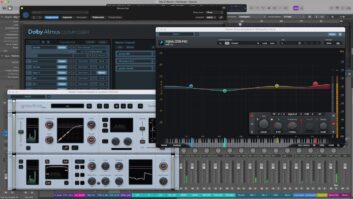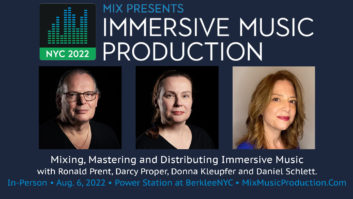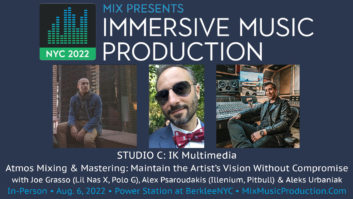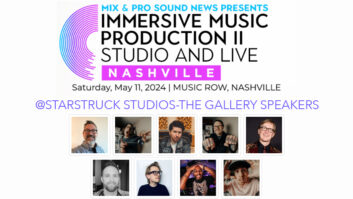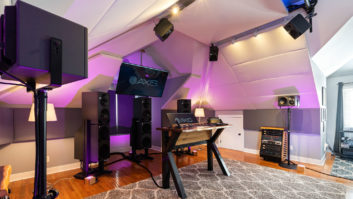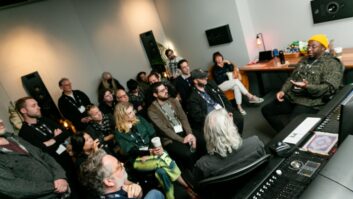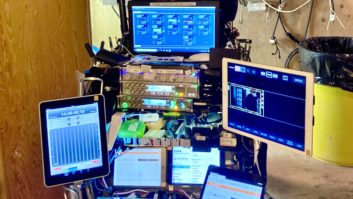
I have been thinking about this question for a while now. I’ve had countless conversations the past couple of years with engineers and producers that I highly respect., and invariably, eventually, the question comes up: “What do you do about mastering?” This question is both from me to the engineers, and from them back to me.
I had a conversation at AES in October 2019 with a longtime friend and fantastic engineer who was excited to let me know that he was mixing in Dolby Atmos. Excellent! I asked him about his room, his process and approach to mixing, and how or where he had his projects mastered. He replied that he just made the proper ADM file and sent it to the label. He said that he wasn’t sure how it could be mastered or why it might need to be. I was a little taken aback.
But his concern shifted when he said the thing that concerned him the most is that he only mixed five of the 10 songs for the release, and he didn’t know how the other songs would be completed, or if they would go together as a body of work for the artist. Exactly.
Who would be putting together the tracks for authoring the Blu-Ray, or making sure the formats and metadata were correct for digital distribution? Who would make sure that the songs and files were properly prepared to be archived and best suited for future formats? Who would listen objectively to make sure that the music presents itself as best as possible across multiple formats and playback systems? That “other set of ears”? And on it went.
This conversation has been repeated in various forms at trade shows, conventions and in talks with producers, engineers and artists alike who want to be working in the formats, but are not entirely clear on some of the details like deliverables and distribution.
I have been mastering audio in surround formats—and now, immersive audio—for 20 years, on releases for Marvin Gaye, Sting, YES, Sheryl Crow, Colorado Symphony, Soundgarden, Rob Thomas, America and many more. Most recently, I’ve worked on Dolby Atmos releases by Kenny Wayne Shepherd and Alicia Keys. I have also been working with Dolby, Sony, Fraunhoffer and other organizations to help develop the tools and procedures for mastering immersive audio. As an industry, developing an efficient and inclusive way to create immersive audio requires ongoing conversations between mixing and mastering engineers, and the companies creating the software.
I am a big fan of immersive audio. I built my first surround (5.1) room in 2000 and had been working in that format until 2018, when I converted the main room at Coast Mastering to a 7.1.4 system. The last year and a half have been spent lifting my house, digging down underground so that we could get 14 feet of height, and building a 9.1.6 mastering facility.
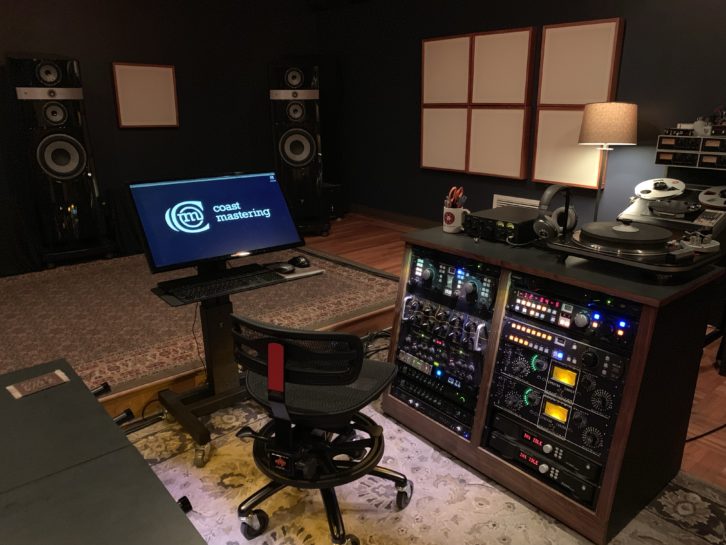
The monitoring environment is crucial to any mastering facility, and especially so once you start adding more speaker channels. Proper construction, speaker placement and tuning is paramount to a good immersive monitoring environment. I have been fortunate to have Bob Hodas tuning every mastering room I have worked in during the past 26 years.
Put simply, mastering is the point where art and science come together. Or, the subjective and the technical. The technical side is knowing how the music is going to be distributed, and delivering the best masters appropriate for each format and stream. The artistic side starts with translatability and presentation. Music has its best chance to be enjoyed as an artistic expression if it translates, meaning that it sounds as good as it can on as many different systems as possible.
So, what is Immersive Mastering? Exactly the same thing. It is receiving mixes, listening very carefully to them, then deciding what, if any, adjustments need to be made with regards to balance, levels, tonality, etc.—for all of the songs. Once the artistic decisions have been made and approved, the next step is to create the correct masters for distribution. The main difference between stereo and immersive mastering is in the complexities of the channels and the delivery.
The Challenges
The first big challenge is receiving the mixes. What gets sent to the mastering engineer? Individual tracks, ADM files, stems? A combination? Sometimes the answer is based on what software the mastering engineer is using. Right now, there are very few tools available for immersive mastering. As an example, if I want to use an EQ for a song, I would like to be able to apply it to any, all or some of the channels. I would also like to see a compressor/limiter that would allow me to link or trigger for any single or grouped audio, or be able to apply the same amount of dynamic reduction across all channels that are linked, based on the trigger channel. For now, we need to work around the limitations of our tools.
DAWs present another challenge. It is unrealistic to try and master out of the box. I wish I could, as I greatly prefer it for stereo work. So I choose to use Steinberg Nuendo, as it can easily handle the different types of objects, beds and output bus structure. I can use it to import different ADM files which include the positional metadata for the object tracks in place. Or, If I get sent 12 channels of audio, for example in a 7.1.4 project, I can pan those to the correct speaker positions and proceed from there. I wish there were more options for immersive mastering.
Delivery for Immersive Audio to the manufacturers or streaming services is another challenge. Each platform has different requirements. And each format has its own software for creating those deliverables. Dolby has the Atmos Mastering Renderer, Sony has Architect, Fraunhoffer IIR reverb and 3DAConversion tool. Et cetera.
Finally, I want to touch on down-mixing. For me, down-mixing does not work in practice. Each channel-type of delivery is best when it is created specifically. Each version—2.0, 5.1, 7.1, 5.1.4, 7.1.4—is best when each has its own mix. There are timing and phase issues that I feel must be dealt with by the mix engineer to achieve the best results. You can’t put ten pounds of flour in a five pound bag.
Here’s a story to help me explain: When Giles Martin remixed Sgt. Pepper’s in Dolby Atmos, the two questions that kept coming up, from fans and from professional engineers, were: “Do you like it?” And “Is it better?”
I decided to do an experiment and hold an all-day AES listening session with about 15 other engineers to compare every version of the record we could find: Original mono LP, stereo LP, re-mastered, re-released, Hi-res, surround, U.K. vs. U.S., etc. When the day was over, my favorite was still the original mono LP. Here’s why:
The art and craft that was needed to have all of the individual sounds and instruments be heard in their own sonic place out of one speaker was tremendous. If you spread those out an immersive format simply as is (which is NOT what Giles Martin did, by the way), each piece of audio would be a weak representation of itself because the context of space is different. Simply spreading doesn’t work.
The exact opposite is true when down-mixing. Folding all of the textures down to a smaller listening view is trying to cram more sound in a smaller space. It becomes a dense mess with no clarity or sense of localization. Algorithms don’t know the intent of the artist or the engineer to know what to sculpt to make the space.
This applies to mastering, as well. When I am mastering a project, I am listening for the authentic nature of the presentation and the tone and space each element takes up. Not what it is, but how it is. The art form of Immersive Mastering is in making sure that the tonal and level transition occur smoothly across the sound sources. Filling in the sonic gaps and pulling back the peaks, if needed.
Ideally, Separate Mixes
The best case is that we receive separate mixes for each format. The best LP press is going to come from a master made specifically for the format. Not an over-compressed set of CD files. The same is true for immersive audio. Blu-ray discs are still the best and most common way of delivering physical immersive audio. MSM in Germany has a system called M-Shuttle. They can author several versions of the audio on the same disc. Dolby Atmos, Auro-3D, 5.1 discrete and hi-res stereo on the same disc, for example. And the consumer can choose to listen to their preference. It’s a great way to give the listener a choice based on their preference or system. Ideally, each of those formats would have their own mix, specifically matching the channel count.
The complexities of the immersive formats, in every stage of the production, are far greater than stereo. Mastering is an essential part of the process of making records. A mastering engineer with skill and an ear to be attentive to the last detailed steps before release is a crucial part of the success of the format.
I believe very strongly in the human element and what it brings to the technical capabilities getting the listener closer to the intention of the art form. What moves me about all music, mono to immersive, is its ability to pull me in. The way it can tell you a story, or take you on a journey, is powerful. What I love about mastering for immersive audio, and stereo mastering, for that matter, is trying to help make sure the artist sounds more like themselves, wherever or however their music is being heard. The consumer then become more of an active listener than a passive listener. What the artist is saying musically becomes more important than how they are saying it. That’s when we get pulled in. That’s when we stop what we are doing and just… Pause. Listen. Nice.

